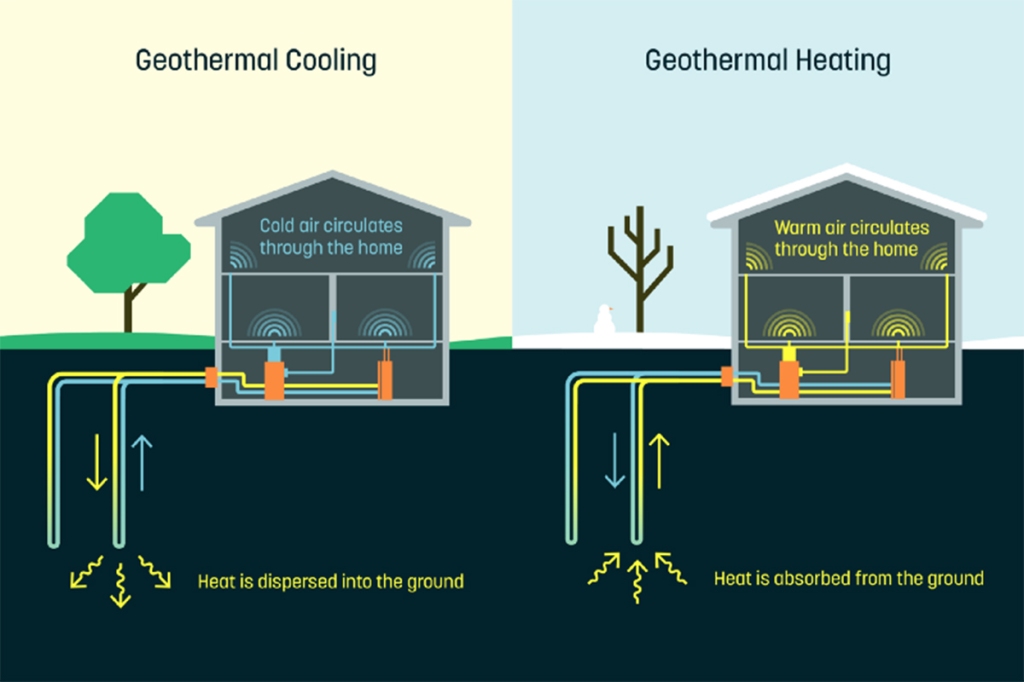Biomass energy is derived from organic matter such as plants, agricultural waste, and wood pellets. It is an excellent renewable energy source because it can be produced continuously through the use of sustainable farming practices. Biomass energy can be converted into heat and electricity in power plants or used directly for heating and cooking purposes.
Ocean thermal energy conversion (OTEC) utilizes the temperature difference between warm surface water and cold deep water to generate electricity. OTEC systems are typically located in tropical regions where there is a significant temperature gradient in the ocean. This technology has great potential for producing clean and reliable power on a large scale.
Geothermal heat pumps harness the natural heat stored beneath the earth’s surface to provide heating, cooling, and hot water for residential and commercial buildings. By taking advantage of stable underground temperatures, geothermal heat pumps are highly efficient, reducing both greenhouse gas emissions and energy costs.
Tidal power captures the kinetic energy of ocean tides to generate electricity. As tides rise and fall, turbines are placed underwater to capture this movement and convert it into electrical power. Tidal power is predictable, reliable, and has minimal environmental impact compared to other forms of renewable energy.
Wave energy refers to the capture of kinetic energy from ocean waves using specialized devices such as buoys or oscillating water columns. These devices convert wave motion into mechanical or electrical energy that can be used for various applications including desalination plants or powering coastal communities.
Hydrogen fuel cells produce electricity by combining hydrogen with oxygen from the air, generating only water vapor as a byproduct. Fuel cells offer high efficiency levels and zero-emissions operation when utilizing hydrogen produced from renewable sources like wind or solar power.
Solar water heating systems utilize sunlight to heat water through collectors installed on rooftops or ground-mounted arrays. This technology reduces reliance on fossil fuels for heating purposes while providing an abundant supply of hot water throughout the year.
Microgrids and smart grids are advanced electrical distribution systems that incorporate renewable energy sources, energy storage, and intelligent control systems. These grids enhance the reliability and efficiency of electricity supply while enabling integration of decentralized power generation from renewable sources.
Green roofs and walls involve planting vegetation on rooftops or vertical surfaces to improve insulation, reduce stormwater runoff, and mitigate urban heat island effects. These green spaces provide additional benefits such as air purification, habitat creation, and aesthetics.
Sustainable transportation options include electric vehicles (EVs), hybrids, and public transport systems powered by renewable energy sources. By transitioning from fossil fuel-powered vehicles to these alternatives, we can significantly decrease greenhouse gas emissions and improve air quality.
Energy-efficient appliances and electronics consume less electricity compared to their conventional counterparts. Technologies such as LED lighting, smart thermostats, and energy-efficient refrigerators help reduce overall energy consumption in households.
Eco-friendly building materials include those made from recycled or renewable resources like bamboo flooring or reclaimed wood. These materials have a lower environmental impact during production while maintaining high-quality standards for construction purposes.
Sustainable agriculture practices for energy production involve techniques like bioenergy crop cultivation or anaerobic digestion of organic waste to produce biogas. These practices promote self-sufficiency in energy generation within agricultural communities while reducing reliance on fossil fuels.
Offshore wind farms harness the strong winds at sea to generate electricity using large turbines installed in coastal waters. Offshore wind has significant potential for producing clean power at scale due to its higher wind speeds compared to onshore locations.
Biofuels produced from algae offer an alternative source of transportation fuel that is sustainable and reduces greenhouse gas emissions compared to traditional fossil fuels. Algae can be grown in various bodies of water without competing with food crops for land use.
Waste-to-energy technologies convert solid waste into usable forms of energy through processes like incineration or anaerobic digestion. This approach reduces landfill waste volume while generating heat or electricity.
Green data centers incorporate energy-efficient technologies and renewable energy sources to power their operations, reducing the environmental impact of storing and processing vast amounts of digital information.
Energy storage solutions are crucial for balancing intermittent renewable energy generation with demand. Technologies such as batteries, pumped hydro storage, or compressed air systems enable excess energy to be stored and used when needed.
Distributed generation systems involve generating power close to the point of consumption, reducing transmission losses and increasing grid reliability. These systems often utilize small-scale renewable energy technologies like solar panels or wind turbines installed on rooftops or in communities.
Community-based renewable energy projects empower local communities to develop, own, and benefit from renewable energy installations. This approach fosters community engagement while promoting sustainable development and self-sufficiency in energy production.
Net-zero energy buildings are designed to produce as much (or more) clean energy as they consume over a year. These highly efficient buildings utilize passive design strategies, advanced insulation materials, solar panels, and other renewables to achieve this goal.
Electrification of rural areas with renewable energy provides access to clean electricity in remote locations where traditional grid infrastructure is not feasible. Solar home systems or mini-grids powered by solar or wind offer sustainable solutions for rural electrification.
Renewable energy adoption in developing countries can provide affordable and reliable power while addressing issues related to poverty alleviation and climate change mitigation. Initiatives like off-grid solar programs have already made significant impacts on improving livelihoods in these regions.
Green financing options support the development of renewable projects through various mechanisms like green bonds or investment funds dedicated solely to environmentally friendly initiatives. These financial tools encourage private investments towards a low-carbon economy.
The growth of the renewable sector has led to an increase in green jobs across different industries including manufacturing, installation, maintenance, research & development related activities. These jobs contribute significantly towards creating a sustainable future while providing employment opportunities that align with eco-friendly principles.

Leave a comment